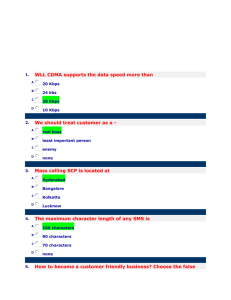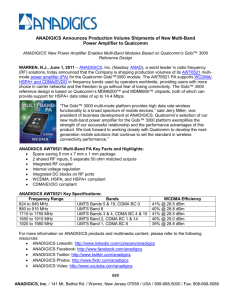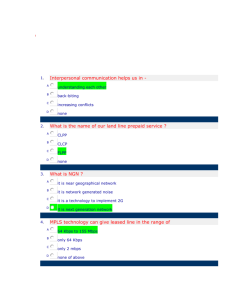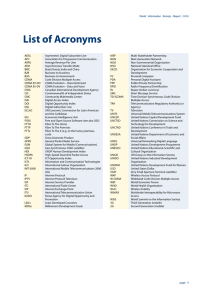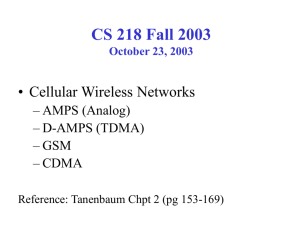1 Luigi Gasparollo Status Opportunity provided by CDMA wireless technologies
advertisement
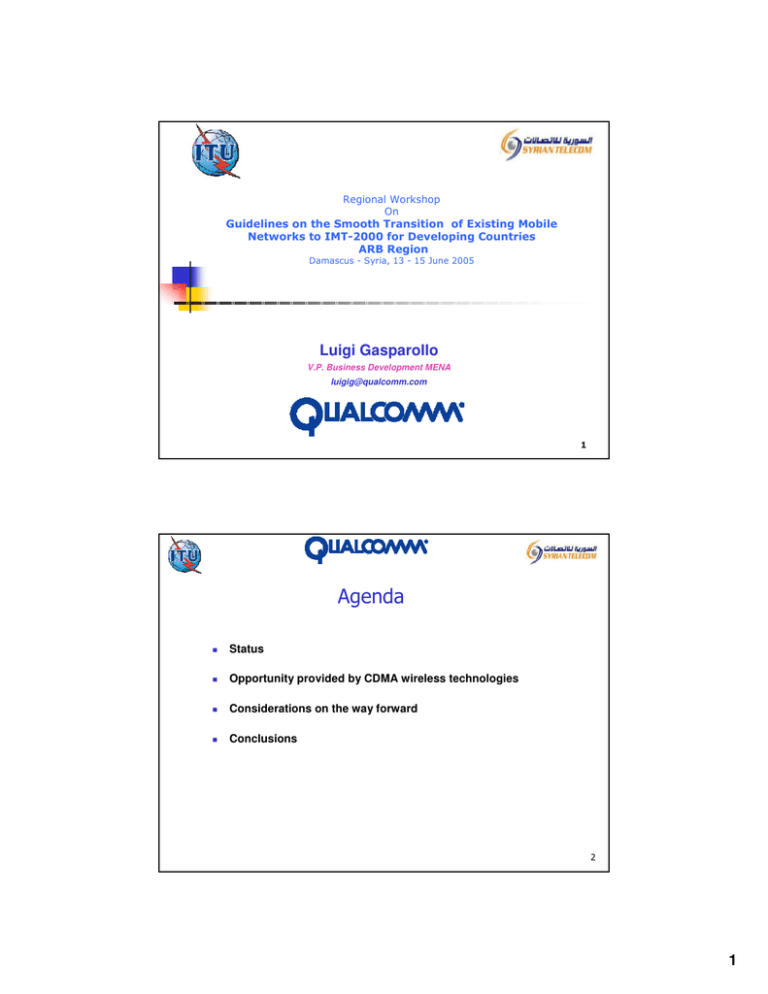
! " #$% $ Luigi Gasparollo V.P. Business Development MENA luigig@qualcomm.com Status Opportunity provided by CDMA wireless technologies Considerations on the way forward Conclusions 1 The evolution of wireless technologies and the relative cost and ease of deployment have modified the telecom landscape of regions of the world. Fixed and mobile networks have had an independent development and to some extent the mobile networks have heavily attracted voice users often as replacement of the fixed voice. Evidence is emerging in several countries that even a large mobile penetration is not good enough to promote economic growth if the fixed infrastructure is lagging behind in its ability to provide voice and data across the country at the right price point as needed to support SMEs modernization/development Average of the African countries have mobile communication by far more developed than the fixed with the result that data and internet access are limited and expensive and therefore scarcely used Wireless technology have reached a price point that enables communication at the lowest cost even in areas heavily underserved by communication Some of IMT 2000 solutions are flexible in use being able to support different services on the same network: fixed, mobile, internet and can work at convenient frequency bands to reduce the initial capital cost thus speeding up the economical development of country with low fixed line penetration. Solutions of this kind using CDMA 2000 have been used in several countries; India is a staggering example in terms of shifting of the cost paradigm; phone services have become accessible to more people, and therefore quickly enlarging the market/customer base the time needed to cover extremely large countries with voice and data service up to 2,4Mbs are very short DSL like services become available at attractive prices. As result of volumes, and entry of new players in the market, the costs have sizably decreased enabling solution for more countries Regulators need to give suitable attention to the national priorities by allocating sufficient spectrum at lower frequencies where the cost of coverage is lower, hence higher telephone penetration because of lower costs. 2 Providing affordable, ubiquitous, coverage is crucial in mobile communications CDMA 2.1 The warmer (lower) frequencies are best! WCDMA 2.1 TD-SCDMA 2.1 GSM 900 CDMA CDMA 1.7 1.9 CDMA 800 GSM 1.8 CDMA 450 1GHz 802.15.3a UWB 3.1-10.6 802.15.1 Bluetooth 2.4 802.11 b, g Wi-Fi 2.4 802.16 LMDS 28-29 802.11 a, e Wi-Fi 5.0 2GHz 5GHz 29GHz 11GHz 802.16a, e 802.16a, e WiMAX WiMAX 5.8 2-11 cdma2000® 450, 800, 1.7, 1.9, 2.1 Licensed Unlicensed Licensed & Unlicensed Using the lower frequency bands is preferable for providing Universal Universal Access for voice communications, Internet access & multimedia services services 59x SMV1 45x SMV2 (Erlangs per Sector in 5 MHz) 2% GOS for all calculations 39x SMV1 Note: Assumes 100% loading of voice traffic 31x SMV0, EVRC 28x AMR AMR Half Rate Half Rate 18x 11x AMR 1/1 Base Erlangs/Sector Users/Sector Re-use 1 2 3 4 5 52x SMV0, EVRC 5x 17x AMR Full Rate 9x AMR 3/9 4x EFR 1 cdmaOne 2-3 4 AMPS TDMA GSM WCDMA CDMA2000 1x 1x Diversity 3.0 15.8 13.2 – 32.8 52.5 51.5 – 83.1 92.8 – 133.9 154.5 – 175.3 8 23 20 – 43 63 62-95 105-147 168-189 7/21 7/21 3/9 – 1/1 1/1 1/1 1/1 1/1 5 Source: “GSM AMR VOCODERS: FACTS ABOUT INCREASED VOICE CAPACITY” QUALCOMM Internal Paper: Rao Yallapragada Source: "WCDMA for UMTS" , Radio Access for Third Generation Mobile Communications, John Wiley & Sons, LTD., copyright 2000 Source: "The Rise of the 3G Empire", Deutsche Banc Alex Brown, September 2001 Source: "SMV Capacity Increases", Andy Dejaco (QUALCOMM) - reference: CDG-C11-2000-1016010, October 16, 2000. Assumes EVRC = 35users and 2dB power control factor Source: "Further Capacity Improvements in CDMA Cellular Systems", QUALCOMM Inc, Roberto Padovani (Calculations based on 1% Blocking) 3 (Average Throughput per Sector in 5 MHz) 35x Rev A Note: Assumes 100% loading of data traffic Pedestrian Mobility 9x Base GPRS Average Throughput Re-use 7x 3x 1 EDGE 2 WCDMA 28x Rx Div 28x Rx Div 19x 19x 9x 3 CDMA2000 1X 4 5 HSDPA 1xEV-DO 6 128 kbps 430 kbps 900 kbps 1,050 kbps 2,4003,600 kbps 2,4004,500 kbps 3/9 3/9 1/1 1/1 1/1 1/1 1 Assumes 4 time slots @ 12kbps per slot, 3/9 reuse, CS-3 coding scheme maximum (average C/I of 12dB) 2 Source: "EDGE TECHNOLOGY: AN ASSESSMENT" QUALCOMM Internal Paper: Rao Yallapragada 3 Source: "Understanding the Capacity - Coverage Trade-off" Peter Muszynski, Senior Research Manager, Nokia Networks - The GSM World Congress 2000 4-6 QUALCOMM Simulations WCDMA EDGE EV-DO 1xEV-DO 1X $0.02 $0.06 $0.07 0.11 $0.005 Spectral efficiency affects cost (Platinum) GPRS $0.42 Cost = Network Operations Expense + Depreciation on Capital Operators Prefer Mobile Broadband Technologies that are Affordable & Evolutionary Source: The Economics of Wireless Data http://www.qualcomm.com/main/whitepapers/WirelessMobileData.pdf 4 ! % & " ! # ' ( GPRS 20-40 kbps 1X $ ) * + ( , * Peak Rate DL (Commercial devices) Typical End User Data Throughput 60-90 kbps EDGE " & +,#- 70-100 kbps WCDMA (Rel (Rel 99) 200-250 kbps EVEV-DO Rel.0 300- 800 kbps HSDPA (Rel (Rel 5) 300- 800 kbps EVEV-DO Rel.A + Equalizer 360- 960 kbps 0 0.25 0.5 0.75 1.0 1.25 1.5 1.75 2.0 2.25 2.5 2.75 3.0 3.25 3.5 Data Rate (Mbps) 3G CDMA is already standardized – future enhancements are ongoing Notes: 1. Peak and typical average end-user forward link data rates based on actual commercial implementations of each standard. 2. 1X and 1xEV-DO data rates are achieved in a 1.25 MHz carrier bandwidth, WCDMA and HSDPA (Category 12) rates are achieved in a 5 MHz carrier. 3. 1xEV-DO (Rev A) or 1xEV-DOrA data rate includes the implementation of an “equalizer” and reverse link peak data rate enhancement to 1.8 Mbps Most of the countries today have at least two Mobile operators and the key issue is fixed penetration and Internet access at the right price point CDMA 2000 1x has been installed in several countries and the EVDO overlay is being installed on a large majority of the networks, many of which are WLL CDMA networks are no longer to be seen as an alternative to GSM but in this contest can well be considered as a complementary wireless extension of existing networks either fixed or mobile of any standard Both fixed and mobile operators can benefit by extending their business by adding CDMA complement to provide wider bandwidth services CDMA networks properly planned can reach breakeven in a relatively short time even with networks of relatively small scale Full IP configuration are becoming available thus further reducing the operating cost and giving more flexibility in network deployment and integration of fixed/mobile services CDMA All IP network are in general SW upgradeable to Rel. A version that enhances performance and further lower costs of delivery No alternative technology of similar performance has the same economy of scale, maturity and an industrial echo system able to adjust to the different local reality: it is there today!!! ./ 5 ! First IMTIMT-2000 Standard More Voice Capacity (more than 6 times capacity of GSM): • 26 to 29 Erlangs/sector/1.25 MHz (35 to 38 TCH/sector/1.25 MHz) • Capacity gains are directly attributed to: – Fast forward link power control – Lower vocoder rates (rate 1/4 code can be used) – Coherent reverse link Always On Packet Data Rates: • 153.6 kbps peak data rate (Release 0) • 307.2 kbps peak data rate (Release A) Offers a 50% increase in standby time: • Attributed to Quick Paging channel Backward compatible with cdmaOne Voice quality rated as excellent Improved coverage: • 1X provides better coverage due to improved link budget .. Note: Compiled with input from three CDMA operators 1xEV ) 0 (( 1- FLO (Multicasting) 8-11.2 Mbps (6 MHz) $ 2 & +, * Peak Data Rate (Mobile) HSDPA 3GPP Rel 5 7.2 Mbps*** (5 MHz) 1xEVDO IMTIMT-2000 Technologies (Rel. A) 3.1 Mbps** (1.25 MHz) 1xEVDO Rel 0 2.4 Mbps (1.25 MHz) 153.6 kbps (1.25MHz) GSM 1x 9.6 kbps ISIS-95 1993 1995 GSM ! " $ EDGE GPRS < 60 kbps 2000 # $ %% 2001 & ' ( 2002 1.8 Mbps* (5 MHz) WCDMA 1X 14.4 - 64 kbps HSDPA 2003 384 kbps (5 MHz) < 160 kbps 2004 2005 2006 2007 * Based on QUALCOMM’s 1st HSDPA chipset (MSM6275) ** Based on QUALCOMM’s chipset (MSM 6800) *** Based on QUALCOMM’s 2nd HSDPA chipset (MSM6280) . 6 " Services & Market Technology & Standards " Next Generation PAMR(*) Mobile Data Wireless telephony Wireless internet CDMA2000-family of technologies All supported by BREW Platform and A-GPS • High Spectrum Efficiency •PAMR - Private Access Mobile Radio Public Cellular • Maximum site capacity use • Ubiquitous coverage • Efficient data transmission •Lowest cost per Mbs Being used in several counties to increase telephone internet penetration as fixed line and DSL replacement technology . #$%& Enterprise Extend Desktop Experience • Corporate VPN • Large E-mail Attachments • Rich Web Browsing • Graphical Stock Quotes ' Consumers ( ) Fixed Residential Entertainment Focused Between Dial-up & Cable/DSL • Pictures/Imaging • Churn Away from Dial• Video/Audio Streaming up • Video-on-Demand • Replacement for Cable/DSL, • Broadcast Video/Audio where Not Available • Multimedia Messaging • Self-installable Devices • Games Being used in several countries to increase Internet penetration as DSL replacement technology . 7 ( , 3 ' 4 . , CDMA represents an opportunity for increasing telephone and internet penetration in developing countries at the right price point CDMA has time to market and size of market advantage over other technologies in the coming few years for these markets Each technology has to find the suitable slot to enhance communications in the emerging markets without unnecessary constraints Choice of spectrums made available for Wireless solution and licensing policies have a direct impact on economic development Thank you!!!!! . 8
